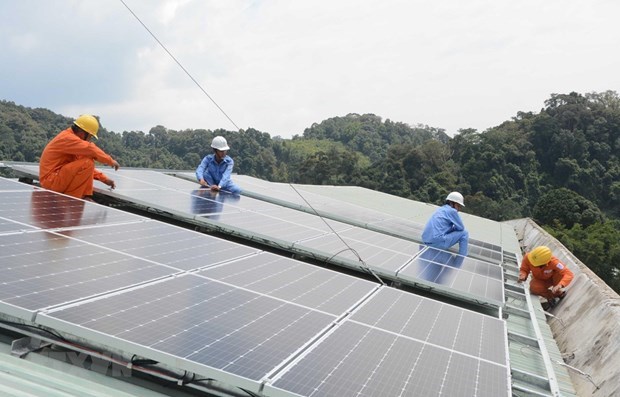
Workers install solar panels in the roof of a building. (Photo: VNA)
The MVEP 2.0, based on the groundbreaking 2016 edition – MVEP 1.0, will be released on February 27. The report has been developed during a time of fast-paced transition towards renewable energy and increasing use of natural gas in electricity production in Vietnam.
The report recommends Vietnam to prioritise renewable energy in national power planning; increase use of natural gas as the current best-fit baseload for renewable energy; construct a regulatory and permitting environment that attracts private sector and smaller scale off-grid investment in clean energy generation and energy efficiency; invest in grid infrastructure to improve stability and capacity; and halt any new approvals for coal.
Six key policy actions are proposed in the report to help Vietnam move toward a more financially, socially, and environmentally sustainable energy future. They include engaging energy specialists from the private sector in producing Vietnam’s Power Development Plan VIII with a strong prioritisation on investment in domestic renewable energy, natural gas, battery storage and energy efficiency.
The report also suggests the implementation of regulatory frameworks and incentives that encourage investment in renewable energies, such as rooftop solar, battery storage, floating solar, and offshore wind projects, with simplified approval processes, while still maintaining safe power systems.
According to the report, Vietnam should standardise the renewable energy Power Purchase Agreement (PPA) and Sleeved Direct Power Purchase Agreement (DPPA) as internationally bankable agreements; publish a Roadmap to Retail Electricity Tariffs to 2025 that depicts the move toward market-based pricing, revising the number of Peak Tariff hours, and consider a differential Retail Tariff in different power regions and for disadvantaged households.
Additionally, the report recommends the country to assess the urgent demands on the grid transmission system and the least-cost means of developing grid infrastructure to support increased renewable energy and increased distributed energy generation; and evaluate the cause and solutions for Vietnam’s extremely high and growing energy intensity as compared to regional neighbours with similar and higher GDP per capita and prepare a public education campaign on reducing energy waste./.
VNA
 Vietnam, Russia cooperate in marine, continental shelf research
Vietnam, Russia cooperate in marine, continental shelf research



